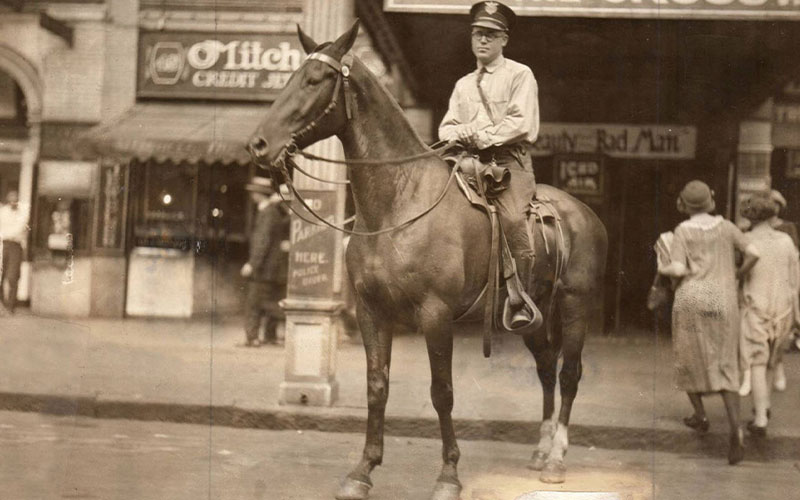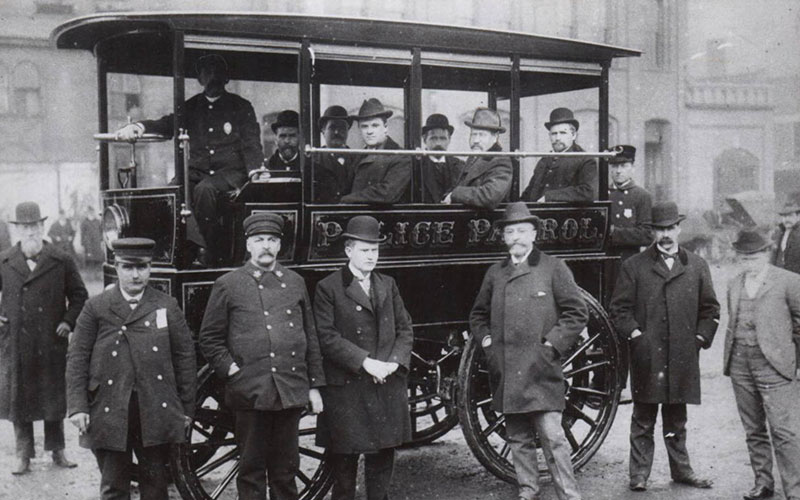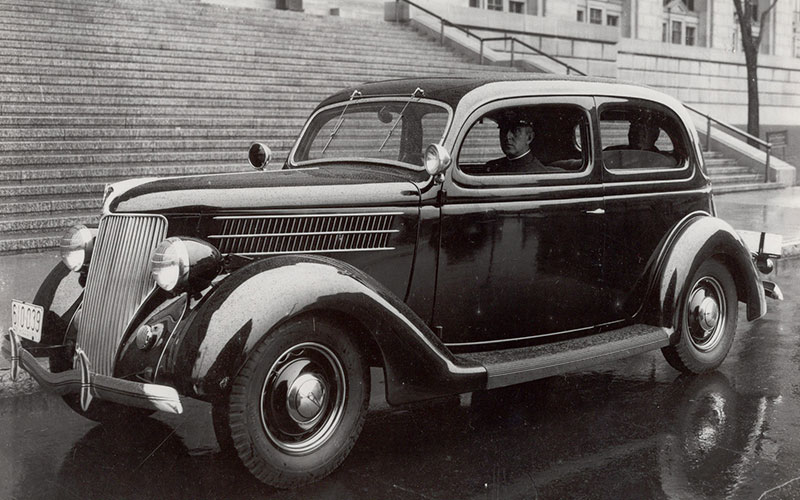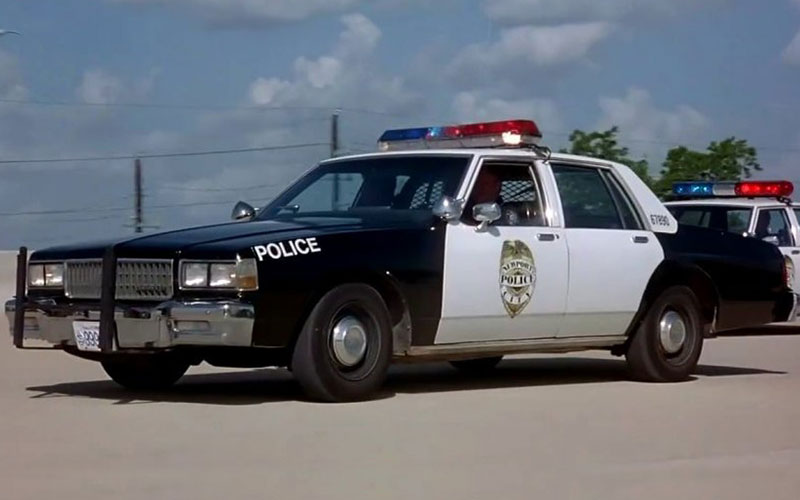A Brief History of Cop Cars
From the first paddy wagons to today’s high-tech Ford Interceptor, these are America’s most memorable cop cars.
The Evolution of the Cop Car

With police cruisers having been a fixture of American roads for roughly one-hundred years, it’s hard to imagine today how thoroughly the automobile transformed policing. Before the adoption of the cop car, police had to settle for horses, bicycles, or their own two feet.
The earliest known cop car in the US was a Collins Buggy Co. electric car fielded in Akron, OH in 1899. It boasted a top speed of 16 mph and a whopping 30 miles of range. Its main function was as a police transport vehicle, but it also sported a cage for prisoners and a gong to serve as a siren. It was reportedly destroyed, pushed into the Ohio river during a riot.

During those early years of the automobile, cop cars tended to be whatever the local police could procure and modify. The advent of the police radio car, pioneered by the NYPD in New York City, proved to be a game changer for law enforcement. Allowing communications with both dispatchers and other patrol cars. The improved mobility and communications allowed few officers to patrol much larger areas.
Ford’s flathead V8 of the 1930s became a favorite of both criminals and the cops who chased them. It was a Ford V8 that Bonnie and Clyde stole and marauded around the Midwest on their crime spree. John Dillinger also famously stole a Ford V8 police car during one of his escapes from the law (incidentally, the restored car was finally returned to Crown Point, Indiana just this past April, 87 years after it was stolen).

Cop cars didn’t get their signature black and white color scheme until the 1950s, allowing them to stand out better in traffic. That same decade was when major manufactures began offering specific “police package” vehicles with special modifications for police use. Ford’s first police Interceptor arrived in 1950, with Chevrolet following in 1955 and Dodge in ’56.
While Ford dominated the cop car market in the early days, Chrysler had overtaken them by the late-1960s and ‘70s. At the height of the V8 craze, police wanted the biggest and most reliable engines they could find, and those came in Chryslers. The 80s saw the introduction of the Ford Mustang SSP (Special Service Package) as well as the Chevrolet Caprice. The iconic Ford Crown Victoria Police Interceptor arrived in the ‘90s, followed by Tauruses and Chevy Impalas and Malibus in the early 2000s.
Today, the Ford Interceptor (based on the Explorer) is the cop car of choice, making up nearly half of all patrol vehicles in service today.
The Usual Suspects

To be sure, there have been a lot of cop cars over the years. Between police special modifications and cities, counties and states doing their own contracting with manufacturers, there are dozens of models that have donned the black and white to fight crime.
Suffice to say, it wasn’t easy to trim down our list of well-known cop cars. Ones like the Dodge Coronet, Ford LTD, and Chevrolet Malibu PPV (Police Package Vehicle) were ubiquitous on American roads. Below are some of the cop cars you’re most likely to see in your rearview mirror.
Chevrolet Bel-Air (50s)

The Chevrolet Bel-Air is an iconic 1950s car and that’s at least partly thanks to its years of duty as a police car. In late-1950s, the Bel-Air police cruiser ran a tuned 4.3L small block V8. In 1957, it received the “Super Turbo Fire,” a 4.6L V8 ported over from the Corvette.
Dodge Polara Pursuit (60s)

Like most police cars, the Dodge Polara gave the cops a leg up when it came to power. The Polara ran a 413-cu. in. V8, know both for its power and its poor fuel economy, until it was replaced by the still inefficient but even more powerful 440 Magnum V8. The 375 horsepower of the 440 allowed the Polara to attain a maximum speed of 147 mph.
Dodge Monaco (70s)

The Dodge Monaco also featured a 440-cu. in. V8. As Elwood Blues elucidated in The Blue Brothers, the Monaco also had “cop tires, cop suspension, cop shocks.” The Monaco was also the most common pursuit vehicle in The Dukes of Hazzard television show, for two significant cameos.
Chevrolet Caprice (80s)

It turns out the Bel-Air wouldn’t be the last coop car to get a Vette motor. The Chevrolet Caprice ran a slightly de-tuned version of the LT1 motor from the third-generation Corvette.
Ford Mustang Special Service Package (80s)

The Ford Mustang SSP was something of a coup for Ford’s sales department. When the California Highway Patrol was looking for a replacement for their Chevy Camaro pursuit cars, which had proven too unreliable, Ford swooped in with their Foxbody Mustang, complete with 5.0L V8. Ford’s tagline for selling the Mustang SSP to police departments: “This Ford chases Porsches for a living…”
Ford Crown Victoria (90s)

Ah, the Crown Vic, today it’s a darling of the used market for its durability, reliability, and oversized V8 engine. Those same qualities were what made the Crown Vic so popular with law enforcement. It’s body-on-frame construction made switching out dented body panels a breeze. An appreciated quality for cop cars used in sketchy high-speed pursuits.
Dodge Charger (2000s)

You know who loves Hemi V8s? Me, you, and lots of police departments. The Dodge Charger is in many ways a perfect police car. Heavy and durable, packing a ridiculous 5.7L V8, and packing a good bit of bad attitude and general menace. The Dodge Charger Police Interceptor demands respect.
Ford Interceptor (Explorer)

Today’s most common police cruiser isn’t even a car. The SUV takeover has extended to law enforcement, too, with the Ford Interceptor based on the Explorer. While not as maneuverable as the sedans of old, the Ford Interceptor has lots of modifications to ensure it stays planted on the road including upgraded tires, beefier sway bars, and bigger brakes. Ford boasts the Interceptor is crash tested to a 75-mph rear end collision and features additional structural reinforcements. There are even more subtle yet substantial modifications that include wider opening hinges on the rear doors, protective “anti-stab” plates in the seat backs, and bullet-proof body paneling.










Sure miss those Big Block old Copcars 440, 454, 429, 460.. 0-60 in 6 sec mark and 14 sec 1/4 miles!
Ii loved it . My husband Jim was a cop for over 25 years, he drove a few of these cars.
That’s great, thanks for sharing!
No Diplomat?